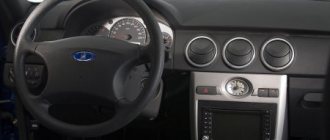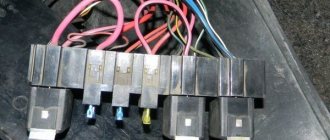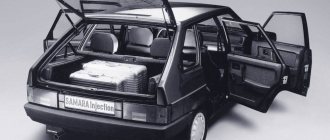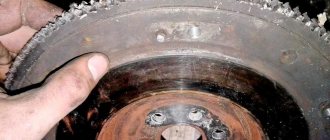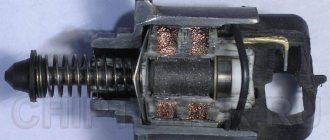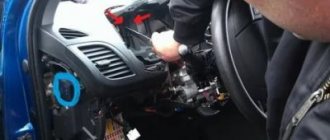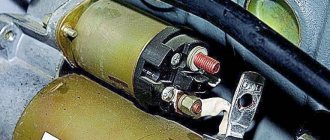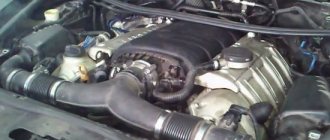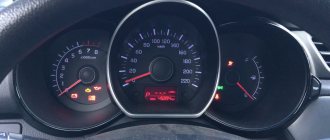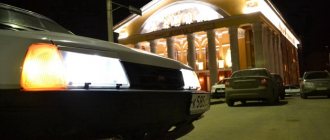Starter device, principle of its operation
The starter of the VAZ-2114 car (factory index - 5712.3708) is a DC power electric motor, additionally equipped with an overrunning clutch with a gear (Bendix) and a retractor relay.
The principle of its operation is very simple: when the ignition is turned on, voltage is supplied to the solenoid relay. Due to the creation of a magnetic field in it, the armature connected to the plug is retracted.
This fork moves the bendix along the rotor shaft of the electric motor and engages the gear with the flywheel ring gear.
In this case, the armature, fully entering the relay, closes the contacts, and voltage is already supplied to the electric motor itself, which is switched on.
The task of the overrunning clutch is also to protect the electric motor. After starting the power plant, the rotation speed of the flywheel significantly exceeds the speed of the gear. It turns out the opposite effect - the flywheel turns the gear.
And so that the force is not transmitted back, after exceeding the speed of rotation of the electric motor, the gear begins to rotate freely on the shaft until the driver turns off the power to the retractor relay, after which the spring returns the bendix to its original position, disengaging the gear.
Read more: Car starter design.
Units and design details
The function of the starter is to start the car engine by spinning its flywheel with an electric motor, creating temporary contact between the gears. Subsequently, the electric motor is turned off and physical contact with the flywheel gear is broken. The starter is located on the engine body closer to the battery and the cab.
Structurally, the device can be divided into two functional blocks:
After starting the engine, the key is returned from the ignition position, de-energizing the relay. The relay opens the contacts, the spring returns the bendix to its original state. When starting, the electric motor requires several tens of amperes of current from the battery. After starting the car engine, the generator restores the battery charge.
Common causes of failure
If on a VAZ 2109 the injector or carburetor stops starting the engine, and the starter does not click, this may be due to various malfunctions.
In general, it should be noted that there can be several options for a malfunction of the starter unit:
- When you turn the key, the device operates once, that is, only one click is heard.
- When I try to start, there are several clicks, but the engine does not start.
- The starter on the VAZ 2109 carburetor does not work completely - there are no clicks.
If the injector does not start, and the starter unit makes only one click, the cause of the problem may be:
- power screws on the solenoid relay, these elements could burn out, as a result of which the voltage supplied to the mechanism will be less than 12 volts;
- a fork designed to push out the bendix, this component could wear out, break or become deformed, as a result the bendix cannot reach the flywheel normally;
- if the car does not start with the key, the teeth on the bendix may have worn off, as a result of which there will be no current from the relay to the starter device;
- wear of brushes or bushings of the so-called anchor;
- winding short circuit.
If the device clicks several times, but does not turn the engine and, accordingly, the VAZ 2109 does not start, then there may be several reasons:
- the battery is dead;
- oxidation of the terminals occurred, as a result of which they became loose;
- The holding winding of the system cannot properly fix the core.
You can turn the key as much as you like, but if the mechanism does not show any signs of life and the engine does not start, then the cause of the malfunction may be as follows:
- short circuit of the winding, if this is the case, then you will hear a burning smell in the car interior, and smoke may even appear;
- collapsed as a ring located in the gearbox;
- very rarely the problem is the key.
If you have dismantled the mechanism and found no damage, try cleaning it and reinstalling it. It is quite possible that after this the VAZ 2109 starter will start working normally (the author of the video is the Avtoelektika HF channel).
Rare situations
They happen noticeably less frequently than those we described above. But under no circumstances should we exclude them.
After reviewing the situations below, compare them with the behavior of your starter and a car that has stopped turning or clicks but does not turn.
- With an injection engine at a frosty temperature of about -20 degrees Celsius, all devices function. This indicates that the battery is fully charged. At the same time, for some reason the starter refuses to turn. Your actions:
- If there are no clicks when you try to start the engine, check the condition of the fuse, wiring and solenoid relay;
- If there is a clicking noise, the most likely source of the problem is the solenoid relay. It must be replaced.
- The engine started normally throughout the day, but in the evening it suddenly stopped working normally. When you turn the key in the ignition switch, there is only a click, but the starter does not turn. When you try to start the engine several times in a row, several clicks are heard. Your actions: Charge the battery;
- Crimp, strip and tighten the contacts on the starter and battery;
- If the first two points do not produce results, check the battery itself. To do this, the wire closes its contacts. If the battery is working properly, a spark will appear that melts the wire;
- Connect the plus from the battery directly to the solenoid relay. If the starter is silent, replace the starter.
- During the day the car started without problems. But after being idle for several minutes, attempts to start the car fail. When you turn the key, the relay is activated, but the starter stubbornly refuses to turn. By closing the two bolts of the solenoid relay, everything started. We reached our destination, stopped, and turned off the engine. When I try to start again, the same situation occurs. Just locking the bolts no longer works. Your actions:
- Disassemble the starter housing;
- Check the condition of the brushes. There is a high probability that they have been completely erased. Hence this effect;
- Replace the brushes with new ones. This is cheaper than completely replacing the unit.
- The starter doesn't turn over. When you try to close it, only noise arises, like when a drill is working. The engine shows no signs of life. But it was possible to start it from the pushrod without any problems. Your actions:
- Make sure your starter is working properly;
- If everything is fine with it, go to the mounting block and check the fuses;
- Also examine the condition of the ignition switch. It is possible that the problem is with him;
- Do not forget to check the wiring for breaks and short circuits;
- Check the status of the contacts. It’s not uncommon that minus does not reach the starter relay only for the banal reason of oxidation or burnt wire.
Having understood the reasons for the failure of the starter, you can bring the device back to life on your own. Don't rush to throw away your old starter and buy a new one. The practice of VAZ 2109 owners shows that partial repairs, and sometimes even simple cleaning of the device, make it possible to restore the functionality of one of the main elements of the ignition system for a long time.
Source
Reasons why a car won't start.
In any case, all the questions of car enthusiasts like “the starter clicks the car cannot, by and large, be combined into one - the car will not start. So, if your car does not start, the reasons for this may be the following:
- violation of the integrity of fuses,
- corrosion on the battery or discharged battery,
- defective ignition switch,
- corrosion on any electrical part, especially the starter,
- there is no spark from the ignition coil (in this case it is worth replacing the coil),
- condensation under the hood,
- problems with the fuel system (in this case, qualified assistance from auto mechanics is required).
One of the most common malfunctions in the car starting system is starter failure. At the same time, you should know how to check the starter in order to determine its serviceability. It is noteworthy that in modern foreign cars, the starter often fails due to the depletion of lubricant or the presence of any contaminants. Of course, to carry out diagnostics, it is best to remove the starter, then it must be cleaned and new lubricant applied (the old one should be removed as thoroughly as possible). If you think that such work is too complicated for you, you can always turn to specialists.
Reasons why the engine may overheat.
Another serious nuisance that can deprive you of driving pleasure for a long time is engine overheating, the reasons for which may be the following:
- Leakage of coolant (antifreeze or water) from the cooling system. To avoid this, you must carefully monitor the integrity of all tubes. You should know the approximate coolant consumption and be wary if this value suddenly increases sharply or after a long stay you see a puddle under the hood,
- ineffective air cooling of the radiator. The reason for this can be even simple dirt under the hood, so you should still keep your car clean,
- malfunction of the thermostat (change in its readings in one direction or another due to its failure),
- faulty adjustment of the ignition or injection system,
- prolonged operation of the engine in off-design modes or, even worse, in conditions of detonation,
- exhaust valve burnout, which leads to an increase in exhaust gas temperature.
These reasons lead to the so-called “external” overheating, that is, one that your existing devices will definitely inform you about. However, there is also “internal” overheating, which is much more dangerous, since temperature sensors do not respond to it. This type of overheating is possible if the engine has accumulated a large amount of foreign deposits in the combustion chamber or on the cylinder head. This can happen due to the use of low-quality coolant (“antifreeze” of unknown origin) or due to the driver’s excessive enthusiasm for chemical additives supposedly to “improve” engine performance. That is why all automobile manufacturers strongly recommend not to skimp on the liquids poured into your car, and also to determine the advisability of using a particular additive specifically for your case. The best option would be to choose one reliable manufacturer and try to purchase only its products all the time.
Why does the engine not start when the starter is working?
Many drivers have more than once encountered a situation where, after turning the key, the dashboard lights up regularly, signaling the presence of fuel in the tank and sufficient battery charge, but when the key is turned to the “engine start” position, the starter, instead of a couple of revolutions, continues to hum, rotating the crankshaft, but the engine does not start.
The reasons for this problem lie in malfunctions of one or more vehicle systems responsible for the normal operation of the engine.
Fuel system
Tank. The fuel level in the tank is measured by a special sensor equipped with a float. If this mechanism malfunctions, the arrow on the dashboard may indicate the presence of fuel when the tank is completely “dry” - the engine cannot be started without fuel.
Pump. Depending on the type of engine and the fuel consumed, the pump can be located in the tank or in the area of the engine group. Designers of injection engines equip their products with an electric pump, the operation of which can be heard in the cab when you turn the key. Carburetor engines supply fuel to mechanical pumps that operate from a central shaft drive. The reasons why the device does not supply fuel may be wear of the electric motor brushes and other parts. Failure to start a diesel engine can also occur as a result of airing of the high pressure fuel pump or a malfunction of the silencing valve.
Fuel filter. After several unsuccessful attempts to start the engine, it is worth checking the condition of the fuel filter. This component does not allow water, dirt and other foreign matter to enter the engine. Failure to replace the filter in a timely manner leads to its complete clogging and blockage of fuel.
Injectors and throttle valve. In gasoline engines, fuel is mixed with air and enters the combustion chambers as a finished mixture. The intensity of the air supply is controlled by the throttle valve, which is driven by a mechanical drive or electric motor. A malfunction of the damper may cause the engine to fail to start. To supply diesel fuel to a group of cylinders, nozzles are used - complex and expensive mechanisms designed to pass strictly dosed portions of diesel fuel into the cylinders. Untimely maintenance of the vehicle and the use of low-quality fuel lead to clogging and failure of the injectors, as well as problems with starting the engine.
Ignition system and electronics
The components of the internal combustion engine ignition system include: battery, high-voltage wires, ignition coil, spark plugs. Also in modern cars, an important component of the ignition system is the electronic control unit (ECU), which receives signals from various sensors built into the engine and controls the operation of the vehicle systems.
Failure to start the engine can be caused by: low battery charge, breakdown of high-voltage lines, faulty ignition coil, spark plugs.
Candles
Unscrew the spark plug, place it against ground and crank the starter. If there is a spark, then there is probably a problem in the fuel system. We will tell you about it later.
It is necessary to do otherwise when the unscrewed spark plug works properly, but it turns out to be wet. Here you should check the timing belt. The latter sometimes jumps off, which disrupts the correct gas distribution and, accordingly, the VAZ engine does not want to start.
If you see that the spark plugs are filled with fuel, then perhaps this very circumstance is preventing you from starting the engine. Dry them with a burner or on a gas stove burner. When they turn out to be wet again during the next attempt, you will have to find out why this happened.
If there is no spark, the cause is sought further. It often lies in problems:
- crankshaft pulley or sensor that controls its position (DCPV);
- computer.
In most cases, the VAZ model 2109 injector does not want to start precisely because of the failure of the DPKV. Failure of other sensors does not prevent the engine from starting, it will simply not work correctly.
Common causes of failure
If on a VAZ 2109 the injector or carburetor stops starting the engine, and the starter does not click, this may be due to various malfunctions.
In general, it should be noted that there can be several options for a malfunction of the starter unit:
If the injector does not start, and the starter unit makes only one click, the cause of the problem may be:
If the device clicks several times, but does not turn the engine and, accordingly, the VAZ 2109 does not start, then there may be several reasons:
You can turn the key as much as you like, but if the mechanism does not show any signs of life and the engine does not start, then the cause of the malfunction may be as follows:
If you have dismantled the mechanism and found no damage, try cleaning it and reinstalling it. It is quite possible that after this the VAZ 2109 starter will start working normally (the author of the video is the Avtoelektika HF channel).
Removing and replacing the starter
Most of the above faults involve removing the starter. This is done like this:
- First of all, it is tedious to de-energize the unit by removing the battery terminals. This is done to ensure that the mechanism does not accidentally operate during removal.
- Then unscrew the nut securing the negative wire and remove the pads.
- All VAZ line starters are secured with three nuts. One on top, the rest below. We unscrew them.
- After this you can remove the starter.
VAZ 2109: starter malfunctions - looking for reasons
Starter for VAZ 2109
A starter, without it you can’t start the car, which means you won’t go far. The success of the trip depends on its performance. Therefore, you need to figure out how to prevent its failure, or fix an existing breakdown. Let’s consider in more detail:
- Alarm Signals
- Malfunctions
Alarm Signals
The starter is the highest-loaded electrical consumer in a car. If, when starting the car, an extraneous sound, noise, crackling appears, or it becomes clear that changes have occurred in the operation of the starter, you must take action without delay. On the VAZ 2109, problems with the starter can be different, some of them can be eliminated with your own hands by reading , how to do it or by watching the video. Here is a small instruction on malfunctions.
Malfunctions
So:
- If the starter on a VAZ 2109 does not start, first you need to do a basic check
- Check if the battery is dead.
- Check the fuse in the fuse box for the starter.
- Check the relay responsible for the starter, it is located in the engine compartment (photo 2).
Changing the relay (Photo 2)
If, however, the starter does not work on the VAZ 2109 and the problem is different, you need to contact a specialist.
- On VAZ 2109 the starter barely turns
- you need to make sure that the battery charge is normal
- Is the alternator belt too tight?
Advice! If the problem is different, you need to contact a specialist; perhaps the starter bushings are worn out or another reason. More often on a VAZ 2109, the starter turns poorly due to wear of the front bushing installed in the engine crankcase.
- On a VAZ 2109, the starter sticks (by turning the key to the “engine start” mode, the starter is activated for 1-2 seconds, which is not enough to start the engine and stops)
- you need to make sure that the terminals on the battery are not heating up, and that the positive wire leading to the starter is not heating up. If it gets hot, it means there is a bad connection.
- The armature bushings may need to be replaced.
- On a VAZ 2109 the starter sticks, in other words on a VAZ 2109 the starter does not turn off (releasing the key after starting the engine, the starter continues to work)
- The additional starter relay (not the solenoid relay) may have failed.
- It is possible that the contacts (nickels) of the starter solenoid relay are sticking.
- Or there is a malfunction in the contact group of the ignition switch - the contacts have fused.
- On a VAZ 2109, the starter does not turn in the cold (the starter turns a little, but with a lot of tension, or does not turn at all)
- Most likely, in the cold, the chemical processes in the battery have stopped. You need to turn on the light for a few minutes; this will help accelerate the battery.
- Another option involves heating the battery in a warm room (do not make the temperature difference too large, for example, placing it in hot water)
- You can also start the car by throwing power from another car
- If the previous options did not help, the battery needs to be replaced.
- On a VAZ 2109, the starter does not turn, the relay clicks (when you hold the key in the “engine start” mode, the relay automatically turns on and off)
- Dead battery
This happens because there is enough battery charge for the solenoid relay to operate. When the contacts close, the starter consumes a lot of current, but this current is not enough for it to work. The voltage on the battery drops, and the solenoid relay returns to its original position. There is no more load, again there is enough current for the retractor to work. The actions are repeated. So:
- On a VAZ 2109 the starter does not turn on (the solenoid relay turned on, but the starter did not turn on)
- Starter brushes are worn out (photo 3)
- The starter may have burned out
- starter jammed
Advice! If the starter is burned out, sometimes it is more advisable to buy a new starter; the price of the starter varies from manufacturer to manufacturer.
The brushes are worn out and do not reach the anchor (photo 3)
- On VAZ 2109 the starter is cracking
- Flywheel teeth are broken or worn. (photo 4)
- The bendix (the mechanism that engages with the flywheel) is worn out.
This is where the starter is cracking (Photo 4)
Advice! One of the most common starter malfunctions is armature play. How to eliminate play in the VAZ 2109 starter armature. The sliding bushings need to be replaced. The greatest difficulty for some is replacing the front bushing located in the crankcase (photo 5). Namely, how to get this bushing?
Solutions
So:
- We select a suitable tap, screw it into the bushing and pull it out.
- Or cut the bushing with a sharp object (screwdriver, small chisel, etc.)
Bushing in the body (photo 5)
At first glance, there are a lot of starter malfunctions, but nothing is impossible. What is made by human hands can definitely be repaired, and with the necessary knowledge and skills, this can be done much faster and with better quality. Good repair.
Starter bushings
Another reason could be worn copper-graphite bushings on which the rotor rests. One of them is pressed into the rear housing cover, where the brushes of the electric motor itself are located, and the front end of the rotor rests on a bushing, which is pressed into a hole in the clutch housing or in the starter housing itself, if the structure is closed.
The first option has almost gone out of use, because the bushing located in the clutch housing quickly breaks, the rotor begins to rotate misaligned and quickly becomes unusable. The second option is widespread almost everywhere, and bushings in this version are much more durable.
However, they also wear out over time and play appears, which eventually leads to jamming.
Why does the starter click but not turn?
Components of a starter using the example of a VAZ 2114
Novice drivers are often mistaken, thinking that the clicking noise is caused by the starter relay. But in fact, the source of the sounds is the retractor device, which engages the Bendix operating gear with the engine flywheel crown and ensures its starting.
If you hear several clicks
Experienced drivers can determine by the nature of the clicks exactly where there is a malfunction. If you hear several clicks when you turn the ignition key, you should look for a problem in:
- traction relay that supplies voltage to the starter;
- poor contact between relay and starter;
- insufficient contact of mass;
- other starter contacts that do not fit well together.
The proper operation of the engine starting system depends on the normal functioning of each component. And it doesn’t matter what car you drive: Priora or Kalina, Ford, Nexia or another foreign car. Therefore, you first need to check the electrical connections, starting from the car battery terminals to the starter contacts. This often helps to start the engine, get to the nearest service station and conduct more detailed diagnostics of the starting system.
One click is heard
A powerful click and the engine not starting indicates a problem in the starter. The sound itself indicates that the traction device is working and electric current is flowing to it. But the charge force supplied to the retractor is insufficient to start the engine.
You should try to start the engine several times (2-3) with an interval of 10-20 seconds. If attempts are unsuccessful, then the following reasons are possible:
- the bushings and internal brushes of the starter are heavily worn and must be replaced;
- there is a short circuit or break in the winding inside the unit;
- burnt contacts of the power cable;
- the retractor device has failed and is blocking the start;
- problems with bendix.
Faulty bendix is one of the problems
Bendix teeth may be damaged and prevent the starter from starting properly.
Bendix plays an important role in starting the internal combustion engine (ICE). It is part of the starting system and is located in the starter. If the bendix is deformed, then starting the engine will be difficult. Here are two common Bendix malfunctions: damage to the teeth of the working gear, failure of the drive fork.
The retractor and bendix are connected to each other by a fork. If full retraction does not occur at the moment of switching on, the teeth will not engage the flywheel. In this case, the engine does not start.
Forced starting of the starter by closing the contacts
In order to put knowledge into practice, you will need the help of a partner (preferably) and a long screwdriver or wrench. The idea is that the metal base of the tool needs to close the power contacts of the starter and apply voltage to its winding directly.
A spark may occur
Alternative methods (if there is no key)
In addition to this method, there are several more. One of them involves starting the starter from the passenger compartment. To do this, you will need to remove the plastic panel located under the steering wheel of the car. Separate the bundle of wires going to the ignition switch from it.
Disassembling the steering column mechanism
First of all, we are interested in the wire going to ground (black or green, sometimes yellow with a black stripe). You can correctly determine whether it is correct or not using a multimeter. To do this, the tip is connected to the one we are interested in, the second to the body of the machine. A zero on the device screen will confirm that this is the correct wire. Its stripped end is isolated and moved to the side.
The one responsible for the starter is determined as follows: the power wire is closed with the remaining ones. The one from which the mechanism will work and will be its supply wire.
The remaining beam is connected to the positive one, after which it is struck with the “starter” one. If determined correctly, the engine should start
It is extremely important when starting in this way, not to short-circuit the wires for a long time, as this will discharge the battery very quickly.
Video.
Hello, dear car enthusiasts! All. But, especially car enthusiasts of VAZ models. VAZ starters, despite their reliability, durability and endurance, still fail sooner or later.
The average starter life is usually 5-6 years, which is half the life of the engine. And whether it’s a malfunction of the VAZ 21093, VAZ 2109 or 21099 starter, the problem will still have to be solved by diagnosing, repairing, and possibly even replacing this electrical component.
Since the VAZ starter design differs only slightly, we will take into consideration the situation when the VAZ 2109, 21099 starter does not turn.
After turning the key in the ignition, you may find that:
- VAZ 2109,21099 starter does not work after a single click;
- The VAZ 2109, 21099 starter does not work after a whole “trill” of frequent successive clicks;
- The starter response to turning the key is completely absent.
What to do if the starter does not work? Of course, look for the cause of this phenomenon and try to eliminate it.
VAZ 2109, 21099 starter does not work after one click
Reasons why the VAZ 2109, 21099 starter does not turn,
after a single click, there may be several.
Perhaps the power bolts on the . This defect leads to the fact that from the supplied 12V, only about 6-7V reaches the starter.
The fork that pushes out the starter bendix may be bent, broken, or otherwise deformed. In this situation, the bendix does not fully fit the flywheel; the cores only partially enter the coil, preventing the contacts from closing.
The teeth on the Bendix sprocket have worn out. Because of this, the solenoid relay cannot transmit voltage to the starter.
Also, the cause of the phenomenon of “one click” of the starter may be either the order of the armature bushings or a short circuit in the winding.
VAZ 2109, 21099 starter does not work after frequent clicks
A crackling noise from the starter in response to turning the key in the lock may indicate the need to check whether the terminals on it are oxidized or loose.
Repeated clicks are repeated due to the fact that the retracting winding retracts the core, and the holding winding cannot hold it and lets go. This can continue until the battery runs out completely.
Rare situations
They happen noticeably less frequently than those we described above. But under no circumstances should we exclude them.
After reviewing the situations below, compare them with the behavior of your starter and a car that has stopped turning or clicks but does not turn.
- With an injection engine at a frosty temperature of about -20 degrees Celsius, all devices function. This indicates that the battery is fully charged. At the same time, for some reason the starter refuses to turn. Your actions:
- If there are no clicks when you try to start the engine, check the condition of the fuse, wiring and solenoid relay;
- If there is a clicking noise, the most likely source of the problem is the solenoid relay. It must be replaced.
- The engine started normally throughout the day, but in the evening it suddenly stopped working normally. When you turn the key in the ignition switch, there is only a click, but the starter does not turn. When you try to start the engine several times in a row, several clicks are heard. Your actions: Charge the battery;
- Crimp, strip and tighten the contacts on the starter and battery;
- If the first two points do not produce results, check the battery itself. To do this, the wire closes its contacts. If the battery is working properly, a spark will appear that melts the wire;
- Connect the plus from the battery directly to the solenoid relay. If the starter is silent, replace the starter.
car battery
- During the day the car started without problems. But after being idle for several minutes, attempts to start the car fail. When you turn the key, the relay is activated, but the starter stubbornly refuses to turn. By closing the two bolts of the solenoid relay, everything started. We reached our destination, stopped, and turned off the engine. When I try to start again, the same situation occurs. Just locking the bolts no longer works. Your actions:
- Disassemble the starter housing;
- Check the condition of the brushes. There is a high probability that they have been completely erased. Hence this effect;
- Replace the brushes with new ones. This is cheaper than completely replacing the unit.
- The starter doesn't turn over. When you try to close it, only noise arises, like when a drill is working. The engine shows no signs of life. But it was possible to start it from the pushrod without any problems. Your actions:
- Make sure your starter is working properly;
- If everything is fine with it, go to the mounting block and check the fuses;
- Also examine the condition of the ignition switch. It is possible that the problem is with him;
- Do not forget to check the wiring for breaks and short circuits;
- Check the status of the contacts. It’s not uncommon that minus does not reach the starter relay only for the banal reason of oxidation or burnt wire.
Having understood the reasons for the failure of the starter, you can bring the device back to life on your own. Don't rush to throw away your old starter and buy a new one. The practice of VAZ 2109 owners shows that partial repairs, and sometimes even simple cleaning of the device, make it possible to restore the functionality of one of the main elements of the ignition system for a long time.
Why does the VAZ 2109 starter not turn?
The first thing you need to pay attention to if the engine does not start is whether the starter is turning the engine crankshaft. Naturally, if the starter does not turn the crankshaft, the car can only be started with a pushrod
Since the starter's job is to turn the crankshaft until a spark catches the engine.
Starter VAZ 2109
To begin discussing possible malfunctions of why the starter does not turn, let's pay attention to what happens when you turn the ignition key to the starter position: 1) A single click is heard. 2) Multiple clicks are heard
3) Nothing is heard 1) The reason for the single click when turning the ignition key is either the ignition relay or the VAZ 2109 starter solenoid relay.
Starter solenoid relay
It is necessary to check all connectors on the starter itself and the solenoid relay. If this clicks the starter solenoid relay, then we check the following things: a) The starter brushes are worn out b) Burnt contacts on the solenoid relay c) The fork that pushes the starter bendix could be broken
Attaching the starter to the gearbox
d) The starter cannot turn the crankshaft for some reason. For example, after the timing belt breaks, the piston rests against a valve that is not retracted. 2) If multiple clicks are heard, they mean that the voltage on the solenoid relay is not enough to turn it on. The reason for the low voltage at the starter solenoid relay may be: a) Dead battery b) Poor contact at the battery terminals. 3) If you don't hear anything when you turn the ignition key, see if the instrument panel lights up. Maybe a mass has just fallen off the battery. If the instrument panel lights up, then the reasons that the starter does not turn are as follows: a) The contact group of the ignition switch has fallen apart
b) Ignition relay is faulty
Starter activation relay
c) Short circuit in the starter. If this malfunction occurs, the starter will begin to heat up and a characteristic smell and possibly smoke will appear.
Individual situations
If the VAZ 21099 injector stops starting, you can try to close the contacts of the mechanism in a straight line.
But sometimes there are emergency situations when the device stops functioning, let’s consider a few of them:
- The injection engine does not start in cold weather, but all devices work normally, the battery is charged. If there is no click, you should first diagnose the safety components, electrical circuit, and also the solenoid relay. If the device clicks, the relay must be replaced.
- The starter turns all day, there is a spark, but in the evening the engine stops starting. Before checking the starter, it is necessary to fully charge the battery, and then clean the contacts on both the battery and the mechanism itself. If these steps did not help solve the problem, you need to check the battery itself more carefully - try closing the contacts with a wire, which may cause a spark to melt. If this does not help, try applying a positive charge from the battery directly to the relay. If there are no changes, the unit will have to be replaced.
- If the car was operated normally all day, but after parking for five minutes it stopped starting, you can try to close the mechanism. You need to directly close two bolts on the relay; if this helps, but later the problem reappears, then disassemble the unit completely. Most likely, the problem lies directly in the erasing of the brushes. In this case, they will need to be changed.
- The unit does not turn at all, but the car can be started from the pushrod. If the problem is not with the starter, then check the fuse box and ignition switch. But before this, you should check the wiring - the reason may lie in the oxidation of the contacts.
Loading …
Why does the starter not turn or click on a VAZ-2109 and how to fix it
Whether the VAZ-2109 will start or not depends on the correct operation of the starter. A starter malfunction may consist of either a breakdown of the unit itself or wear of individual elements of the electrical circuit. We propose to consider a breakdown when the starter does not turn and the retraction relay also does not work, what are the reasons for such features of the car’s functioning and how to eliminate them.
Why doesn't the starter turn or click?
The absence of starter rotation is possible together with the absence of a relay activation mechanism. If the relay is working properly, a click is heard, if not, there are no sounds when you turn the ignition key. Experts note the following main reasons why the starter does not turn or click on the VAZ-2109:
- the tip has come off the wire connected to the terminal and located on the retractor relay;
- there is no charge on the battery;
- the terminals from the battery have oxidized;
- the mechanism relay is damaged, for example, the terminals are oxidized or a break appears;
- the wiring in the contact component of the ignition switch is disconnected (how can you accurately identify these wires? They are colored pink and red);
- The solenoid relay does not work correctly, it may become jammed, or the device has warmed up and now needs to be replaced.
